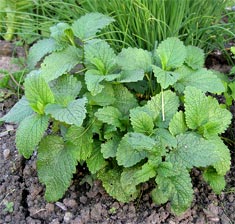Lemon Balm (Melissa officinalis)

Also Known As: Melissa, Sweet Balm, Honey Balm, Cure-all
Uses: Teas, salad, insect bites
Parts Used: Leaves
Lemon balm is an easy to grow herb that not only attracts bees to the garden, but is also a great anti-viral, anti-oxidant and anti-bacterial with relaxing properties that are helpful for soothing frayed nerves and calming hyper children. Melissa in Greek means "honey bee" and lemon balm has many of the tonic qualities as the queen bees favorite royal jelly.
Traditionally, it’s been used to gently treat colic and upset stomach in everyone from infants to elders. A leaf can be chewed to freshen the breath or crushed and placed on a bug bite to help ease the itch. As a medicinal plant, lemon balm has traditionally been employed against bronchial inflammation, earache, fever, flatulence, headaches, high blood pressure, influenza, mood disorders, palpitations, toothache and vomiting. A tea made from Lemon balm leaves is said to soothe menstrual cramps and helps relieve PMS. Even pre-Middle Ages, this member of the mint family was used to treat a variety of health conditions. We’ve included lemon balm in our Happy Bee Blissful blend.
GardenTips:
Lemon balm can grow in most types of soil, but well-drained clay or sandy loam is best. Lemon balm can also handle acidic and very alkaline soil, but it prefers a pH range of 6.0 to 7.5. It thrives best in full sun to partial shade. This perennial grows in Zones 4a through 9b, and best in Zone 7, where it can be harvested until the end of November. Lemon Balm can grow well in most climates, although it prefers drier climates. Space seedlings around 12-15 inches apart. This plant responds well to cutting back, so plan to use lots of fresh, flavorful leaves to brew tea, flavor fruit or green salad and season fish. Be sure to include a stem in a bouquet of summer flowers.
For educational purposes only. This information has not been evaluated by the FDA. This is not intended to diagnose, treat, cure or prevent any disease.

Follow us